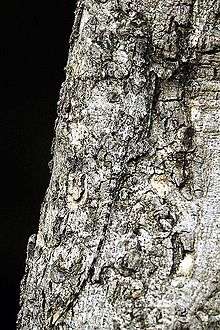Draco indochinensis
| Draco indochinensis | |
|---|---|
 | |
| A very well camouflaged D. indochinensis from Bandipur National Park, India | |
| Scientific classification | |
| Kingdom: | Animalia |
| Phylum: | Chordata |
| Subphylum: | Vertebrata |
| Class: | Reptilia |
| Order: | Squamata |
| Suborder: | Iguania |
| Family: | Agamidae |
| Subfamily: | Draconinae |
| Genus: | Draco |
| Species: | D. indochinensis |
| Binomial name | |
| Draco indochinensis M.A. Smith, 1928[1] | |
Draco indochinensis, commonly known as the Indo-Chinese flying lizard, is a species of agamid lizard endemic to South-east Asia.
Description
It has earlier been considered synonymous to or a sub-species of Draco blanfordii.[2][3] However, phylogenetic data and other supporting morphological features indicate that it is a separate species.[4] The dewlap of the male of this species is widest at its base and decreases in width over its entire length and terminates in a sharp point, as opposed to the distal expansion of the dewlap seen in Draco blanfordii. This feature may be shared with other Draco lizards. Both sexes have a thick, black transverse band that extends across the posterior gular region from one throat lappet to the other. Dark radial bands on the dorsal surface of the patagia of both sexes is also another feature.
The snout-to-vent length is about 108 millimetres (4.25 in). It has a moderately slender body and the nostrils are orientated upwards. The dorsal surface is mottled brownish-grey with darker speckling. The patagium (winglike membrane) is dark brown near the edge and paler brown near the body, with six transverse pale-edged bands. The ventral surface is yellow or pinkish, with the gular pouch a creamy yellow anteriorly, and bluish-grey and black posteriorly. The underside of the patagium is yellowish-brown.[5]
Distribution and habitat
The Indo-Chinese flying lizard is native to southeastern and eastern Cambodia and southern Vietnam. It is found in evergreen forests at altitudes of up to 500 metres (1,640 ft). It is an arboreal species and seldom descends to the ground. Little is known of its diet and behaviour.[5]
References
- ↑ Smith MA. 1928. "Description of a new species of Draco from the Indo-Chinese region". Annals and Magazine of Natural History 10 (2): 248.
- ↑ Inger RF. 1983. "Morphological and ecological variation in the flying lizards (genus Draco)". Fieldiana Zoology New Series 18: 1-35.
- ↑ Musters CJM. 1983. "Taxonomy of the genus Draco L. (Agamidae, Lacertilia, Reptilia)". Zoologische Verhandelingen 199: 1-120. PDF
- ↑ McGuire & Heang. 2001. p. 220.
- 1 2 Indraneil Das (2015). A Field Guide To The Reptiles Of South-East Asia. Bloomsbury Publishing. p. 184. ISBN 978-1-4729-2059-1.
Further reading
- McGuire, Jimmy A.; Heang, Kiew Bong. 2001. "Phylogenetic systematics of Southeast Asian flying lizards (Iguania: Agamidae: Draco) as inferred from mitochondrial DNA sequence data". Biological Journal of the Linnean Society 72: 203-229.